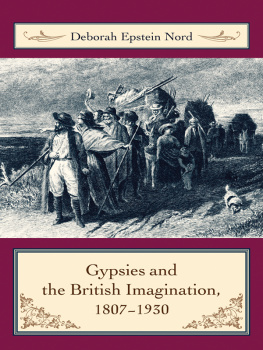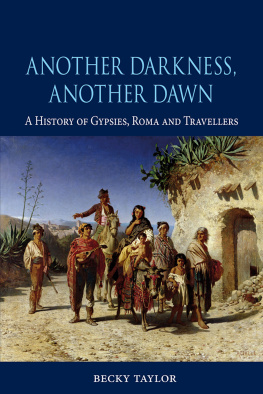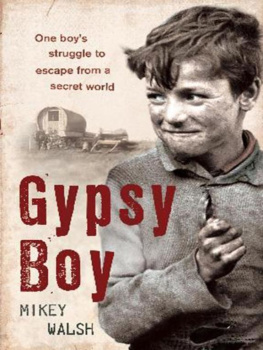IN SEARCH OF THE TRUE GYPSY
IN SEARCH OF THE TRUE GYPSY
From Enlightenment to Final Solution
WIM WILLEMS
Co-ordinator of the Centre for the History of Migrants,
University of Amsterdam
Translated by Don Bloch
First Published in 1997 by
Routledge
Published 2013 by Routledge
2 Park Square, Milton Park, Abingdon, Oxon OX14 4RN
711 Third Avenue, New York, NY, 10017, USA
Routledge is an imprint of the Taylor & Francis Group, an informa business
Copyright 1997 Wim Willems
British Library Cataloguing in Publication Data
Willems, Wim, 1951
In search of the true gypsy : from enlightenment to final
solution
1. Gypsies
I. Title
305.891497
Library of Congress Cataloging-in-Publication Data
Willems, Wim.
[Op zoek naar de ware zigeuner. English]
In search of the true gypsy : from Enlightenment to Final Solution / Wim Willems ; translated by Don Bloch.
p. cm.
The Dutch original was originally presented as the author's thesis (doctoral)Leiden.
Includes bibliographical references (p. ) and index.
1. GypsiesEurope. 2. EuropeEthnic relations. I. Title.
DX145.W5513 1997
305.89149704dc21 | 97-22020 |
CIP |
All rights reserved. No part of this publication may be reproduced in any form or by any means, electronic, mechanical, photocopying, recording or otherwise, without the prior permission of the publisher.
ISBN 13: 978-0-714-64688-6 (hbk)
ISBN 13: 978-0-714-64222-2 (pbk)
Typeset by Vitaset, Paddock Wood, Kent
Publisher's Note
The publisher has gone to great lengths to ensure the quality of this reprint but points out that some imperfections in the original may be apparent
Contents
2. Heinrich Moritz Gottlieb Grellmann (17531804):
an enlightened historian and his sources
3. George Borrow (180381):
the walking lord of Gypsy lore
5. Robert Ritter (190151):
eugenist and criminological biologist
The reader of European history who goes searching for Gypsies will find them only in footnotes. Even today, we still know little about how Gypsies worked and lived down through the centuries. We are guilty of the same ignorance towards non-sedentary groups in general. That during World War Two hundreds of thousands of itinerants met the same horrendous fate as Jews and other Nazi victims has only been recognized tardily and with reluctance. Gypsies appear to appeal to the imagination simply as social outcasts and scapegoats, or, in a flattering but no more illuminating light, as romantic outsiders. The world is patently intrigued by them, yet at the same time regards them with anxiety as undesirable aliens. People are seldom capable of considering Gypsies as creatures of flesh and blood.
Where does such ambivalence come from? What ideas are involved under the surface of these mixed feelings? Since 1985, together with fellow historians Annemarie Cottaar and Leo Lucassen, I have been trying to come to grips with these questions. Inspired by studies conducted by the University of Leiden on the nature of racism, we resolved to shed light on the neglected history of itinerant groups in the Netherlands, especially Gypsies and caravan dwellers. With the passing of time our studies naturally crossed beyond the Dutch borders. I hope that this volume bears the fruits of our ongoing exchange of ideas.
I would like to advise the reader at the outset that this book is not about Gypsies in the usual sense of the term. Although one will find descriptions of their way of life, culture, norms and values, these are there primarily to indicate how people have thought about Gypsies at different times and in different places. To be sure, the descriptions are invariably accompanied by commentary, although questions concerning who the Gypsies are and how they actually lead their lives are allowed to remain unanswered. Instead I trace contemporary notions about Gypsies back as far as possible to their roots, hoping to lay bare why stigmatization of Gypsies, or rather groups labelled as such, has continued from the distant past even to today.
The original Dutch version of this study appeared early in 1995. Research for it was financed by the Netherlands Organization for Scientific Research (NWO), the same body that provided the funds to make this gently pruned English translation possible. For thus enabling an international audience to become familiar with the ideas developed cooperatively in our Leiden project, the NWO has earned my special gratitude. I look back with pleasure on the years spent working together with colleagues at the Leiden Institute for Social-Scientific Research (LISWO), part of the University of Leiden. LISWO provided me with an academic home base rich in facilities. I would like to seize the opportunity to express my appreciation to the staff of archives and libraries in many countries who gave me generous assistance in person or replied by return post to my written requests for information. Their memories enabled me to probe further than I had supposed possible.
Indeed more people have been involved in the genesis of this book than I can mention here. A core of four, however, must not go unnamed. First of all my official project supervisors, the cultural anthropologist Andr Kbben, who emerged as a dedicated guardian of the right tone, and the social historian, Jan Lucassen, whose confidence in my ability to deal with historical materials has not, I hope, been damaged irreparably. My thanks, too, to the well-known English gypsiologist Angus Fraser who mustered the patience to provide detailed commentary to the Dutch text, even though I was not shy about admitting I was unable to share his views on Gypsy history. He may be assured of my respect for such magnanimity. And it was, finally, a privilege to work on this English translation with Don Bloch. His feeling for style and expressiveness have, I am convinced, made the book more accessible.
Wim Willems
Centre for the History of Migrants
University of Amsterdam, May 1996
Introduction
THE POWER OF LABELLING
In 1991, leafing through a stack of Serbian weeklies, the Dutch cultural anthropologist, Duijzings, stumbled upon a number of articles about a new ethnic minority in the former Yugoslavia: the Egyptians.1 The previous year they had founded their own association and within no time at all they had received 6,000 applications for membership; they estimated their total number in Yugoslavia at 100,000. A similar organization had been set up in the Macedonian town of Ohrid ten years earlier. It had acquired 5,000 members and, during the Yugoslavian census of 1981, its members had campaigned in vain for official recognition as a nationality.2 The new association appears, in the interval, to have been remarkably successful at mobilizing support from various sides. It brought out a book featuring the folk tales, legends and customs of Egyptians in Macedonia and presented it to the Egyptian ambassador in Belgrade. Egyptian television devoted a documentary to the new countrymen and politicians, academics and journalists in Macedonia, and Serbia as well, supported their demand for recognition as a separate nationality.









